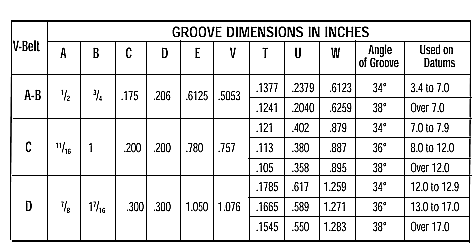V-Belt Drive
INTRODUCTION
v-belts are used with electric motors with drive blowers,compressors,appliances (like mixer,grinder,etc), machine tools (like lath,drilling machine, etc.), farm and industrial machinery, and so on. V-belts are endless and run in grooved pulleys. the grooved pulleys that V-belts run in are called Sheaves.
CONSTRUCTION
V-belts are made in trapezoidal section. the power is transmitted by the wedging action between the belt and the V-groove in the pulley or sheave, this wedging action results in higher force of friction. the groove angle of a sheaves is made somewhat less than the belt section angle. this provides the wedging action of the belt in the groove. the extract value of this angle depends upon the angle of the belt section, the sheave diameter, and the angle of the contact. if it is made to much smaller than the belt, then the force require to pull the belt out of the grooves will be excessive. so usually groove angles of 32 'c and 38'c are used. sufficient clearance must be provided at the bottom of the groove to prevent the belt from bottoming as it becomes narrower from wear. multiple V-belts are used in order to increase the power capacity. as many 12 or more belts are commonly used in heavy-duty applications.
Materials of V-belts
V-belts are made up of cotton fabric and cords moulded in rubber and covered with fabric and rubber
ADVANTAGES AND DISADVANTAGES OF V-BELT DRIVE
Advantages:
- Power transmitted is more due to wedging action in the grooved pulley.
- V-belt is more compact, quiet and shock absorbing.
- the belt drive is positive because the slip is negligible due to the wedge action.
- Higher velocity ratio (up to 10) can be obtained.
- V-belt drive can operate in any position.
- Multiple v-belts can be used, the enabling transmission of more power.
Disadvantages:
- It cannot be used with large center distance.
- It is not durable as flat.
- V-belt is subjected to certain amount of creep, therefore it is not suitable to constant speed applications such as synchronous machines and timing devices.
- It cannot be used for large power.
- The efficiency of the V-belt is lower than that of the flat belt
TYPES OF V-BELT
According to Bureau of indian standards (IS:24494-1974),the V-belt are classified as A,B,C,D and E type (based on the cross-section of V-belts). The various dimensions of on standard V-belts are given below.
Ribbed V-belt
 Ribbed V-belt is a cable cored reinforced transmission belt with 'V' shaped ribbes along with circumference of the belt, as shown in a fig.it is flexible with high power capacity per unit width and designed on completely integrated construction. the ribbed surface provides maximum area of contact and reduced the face pressure. The ribbed V-belt gaining width
Ribbed V-belt is a cable cored reinforced transmission belt with 'V' shaped ribbes along with circumference of the belt, as shown in a fig.it is flexible with high power capacity per unit width and designed on completely integrated construction. the ribbed surface provides maximum area of contact and reduced the face pressure. The ribbed V-belt gaining width
acceptance in the automotive field due to the advantages in exhibits conventional V-belts. ths belts are particularly good for high speed which conventional belts are unable to handle.the smooth, and vibration free performance and excellent revers bend characteristics of this belt enable the design of single belt, compact drive systems.
Applications
Ribbed V-belts have been selected for use on many applications range from the single multi-rib accessory drive concept (SMAC) for passenger cars to water pump, alternator, and air conditioning drives on heavy trucks.
Special features of of ribbed V-belts
- Highly flexible and can be used with smaller pulley diameter resulting in lighter and compact drive.
- Higher power rating.
- Almost eliminates the slippage due maximum wedge contact of the pulleys.
- Gives noise free power transmission in every application.
- Eliminates the necessity to use multiple / matched set of belts.
- Can be use in higher speed more than 40 m/sec
- Reduces down time and hence belt replacement cast.
Construction of ribbed V-belts
Ribbed V-belt sections which are designed by the letter "k" and "J" are easily identified , measuring distance between the adjacent ribs within a belt. The "J" section belt has a smaller rib than the "K" belt and the overall thickness of the "J" is less than the "K".
The polyester tension cords are embedded into belt to achieve longitudinal stability.Then cross wise fibers are incorporated into the polychloroprene substructure for unsurpassed transverse bending strength, finely the belts are ensured for maximum resistance to temperature fluctuations and ozone.
The polyester tension cords are embedded into belt to achieve longitudinal stability.Then cross wise fibers are incorporated into the polychloroprene substructure for unsurpassed transverse bending strength, finely the belts are ensured for maximum resistance to temperature fluctuations and ozone.
Timing (or synchronous) belts
Flat belt and V-belt drives cannot provide a precise speed ratio, because slippage occurs at the sheaves. But the certain applications require an exact output into speed ratio.
In such situations, timing belts are used. The timing belts have teeth that mash with grooves, most timing belts are reinforced with glass fiber, steel or aramid.








2 Comments
Industrial V-belts are rubber belts that are used to power engine mechanisms such as fans, water pumps, domestic washing machines, small fans, refrigerators, and garage equipment. Industrial V Belts are widely used on high speed and high torque drives on light, heavy industrial and automotive machine. For more info, please visit- http://www.polydrive.in/
ReplyDeleteNice post. I found industrial vee belts in India for modern use at a reasonable cost. They have an incredible stun engrossing limit and drive consistency. Love It.
ReplyDelete